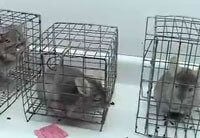From the Investigators’ Notebook: One Day on a Fur Farm
Animals raised for their fur suffer from the time they’re little until the day they are killed.
Inside the breeder rooms, the farmer looked for babies to take away from their mothers. The babies squealed and squealed as he grabbed them and carried them by their tails to the “grower room.” Their mothers were distressed, too; one climbed and pressed against the front of her cage, frantically trying to reach her baby. My partner asked the farmer if the mothers got upset when he took their babies away. “I don’t ask them their opinion,” he said.
At feeding time, the farmer walked down the rows of cages checking if the chinchillas were dead or alive. Many were asleep, since they are nocturnal animals, but the farmer banged on cages to make them move. One chinchilla didn’t move. His hindquarters looked wasted away, completely denuded of fur. The farmer had already told us that his profit margins didn’t factor in veterinary care. He tossed the body onto the festering trash heap he called “Mount Chinchilla.”
Animals who had chewed at their fur (a sign of stress), making them unsuitable for pelting, were housed on a lower rack—”death row”—so that the farmer could scoot alongside the cages in an office chair, killing one after another without exerting himself. He kills these “trash” animals by breaking their necks.
We watched him thrust his arm into a cage, corner the frantic chinchilla inside, and pull him out by his tail. Grasping the chinchilla’s head and jaw, he arched the neck awkwardly backwards. The chinchilla squealed. The farmer then pulled sharply on the animal’s tail, breaking his neck. He tossed the jerking chinchilla to the floor, where the animal writhed in continuous spasms. We asked if he was ever bothered by the killings. “I don’t feel anything,” he replied, and moments later, added, “I could do this all day.”
Other chinchillas are electrocuted so that they won’t thrash around and ruin their coats. Carrying a chinchilla by her tail, the farmer pulled a rusty wire apparatus from a drawer, dipped the sharp clamps into a jar of water, and attached one clamp to the chinchilla’s metal ear tag and the other to her foot. He plugged the device into a wall socket and dropped the chinchilla to the counter. The surge of electricity stiffened her. Her tail stuck straight out, her chest heaved, and a minute later, a yellow trickle ran down the counter—she had lost control of her bladder.
Performed this way, electrocution sends a current through the heart and immobilizes the animal, but it does not stop brain activity. The chinchillas suffer the pain of a full-blown heart attack until their hearts finally stop beating. The farmer admitted that he had been told by a veterinarian to stun the chinchillas first. But he said he didn’t see why stunning them and then electrocuting them would be any different from just electrocuting them, so he doesn’t do it.
After unplugging the device, the farmer clipped the chinchilla’s arms and legs to a pelting board in a spread-eagled position. Slitting her open, he cut her face away from her skull and cut her hands off. Working her pelt away from her body, he pulled her arms out of her skin, which turned inside out like socks. Saying, “She doesn’t need these anymore,” he took scissors and cut off her whiskers, then her ears. Her tail and feet soon followed; they were dumped, along with her naked, skinned body, into a garbage bucket, like so much trash.





